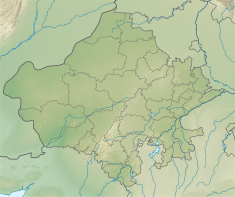Bisalpur Dam
| Bisalpur Dam | |
|---|---|
 | |
| Official name | बीसलपुर बांध |
| Country | India |
| Location | Deoli |
| Coordinates | 25°55′28″N 75°27′20″E / 25.92444°N 75.45556°E |
| Opening date | 1999 |
| Construction cost | 556crores |
| Dam and spillways | |
| Type of dam | Gravity |
| Height | 39.5 m (130 ft) |
| Length | 574 m (1,883 ft) |
| Spillway capacity | 29,046 m3/s (1,025,750 cu ft/s) |
| Reservoir | |
| Total capacity | 1,100,000,000 m3 (891,785 acre⋅ft) |
| Active capacity | 1,040,000,000 m3 (843,142 acre⋅ft) |
| Surface area | 218.36 km2 (84 sq mi) |
Bisalpur Dam is a gravity dam on the Banas River near Deoli in Tonk district, Rajasthan, India. The dam was completed in 1999 for the purpose of irrigation and water supply.[1]
History
The Bisalpur dam was constructed in the 1990s by the Rajasthan state government. During the construction, the people displaced by the dam protested against the state government's rehabilitation and resettlement policy, calling it unjust.[2]
In October 1999, the Ashok Gehlot-led Congress government sanctioned a project to bring the Bisalpur reservoir water to the state capital Jaipur. However, the project could not be implemented because of financial constraints. In 2004, the Vasundhara Raje-led BJP government started the construction of a pipeline to bring Bisalpur water to Jaipur.[3] The project was co-financed by the Asian Development Bank (ADB) and the Japan International Cooperation Agency (JICA).[4] ADB financed the transmission system (including purification), while JICA financed the transfer system with an 8.88 billion yen 30-year loan at an interest rate of 1.3%.[5] The project was opposed by farmers relying on the Bisalpur water for irrigation. On 13 June 2005, 5 farmers were shot dead while protesting the diversion of Bisalpur water to Jaipur.[6] The Bisalpur water reached Jaipur in 2009, leading to public protests in surrounding districts like Ajmer, Bhilwara, Dausa and Tonk, whose residents demanded a share of the water.[7]
Water supply

The Bisalpur dam reservoir supplies irrigation water to the Sawai Madhopur and Tonk districts. It also supplies drinking water to the Ajmer, Jaipur and Tonk districts.[8] From Nasirabad in Ajmer district, the drinking water is also transported to the Bhilwara district via a 15-wagon train, which can carry 2.5 million litres of water.[9]
The reservoir has been called the lifeline of the state capital Jaipur.[10] Currently, around half of the areas under the Jaipur Municipal Corporation get water from Bisalpur. In 2016, the Public Health and Engineering Department (PHED) proposed a ₹ 9.5 billion project to supply the Bisalpur water to the remaining areas of the city.[11]
In 2016, the almost-dry Pushkar Lake was filled with water from the Bisalpur reservoir for the annual Pushkar Fair.[12]
References
- ^ "India: National Register of Large Dams 2009" (PDF). Central Water Commission. Archived from the original (PDF) on 21 July 2011. Retrieved 10 July 2011.
{{cite web}}: Unknown parameter|deadurl=ignored (|url-status=suggested) (help) - ^ Anil Agarwal; Sunita Narain; Srabani Sen (1999). The Citizens' Fifth Report: National overview. Centre for Science and Environment. p. 149. OCLC 928953166.
- ^ "A major water project for Jaipur". The Hindu. 30 January 2004.
- ^ Jonas Joerin; Rajib Shaw; R. R. Krishnamurthy (2014). Building Resilient Urban Communities. Emerald. p. 19. ISBN 978-1-78350-906-5.
- ^ "Activities in India". Japan International Cooperation Agency. Retrieved 10 January 2017.
- ^ Vandana Shiva (2006). Earth Democracy: Justice, Sustainability and Peace. Zed. p. 177. ISBN 978-1-84277-777-0.
- ^ Bhanu Pratap Singh (12 June 2012). "Central Rajasthan has just the Bisalpur dam to quench its thirst". The Times of India.
- ^ Vijay P. Singh; Ram Narayan Yadava (2003). Water Resources System Operation. Allied. p. 323. ISBN 978-81-7764-548-4.
- ^ "Bottled water from desert state will soon reach market". The Times of India. 23 October 2016.
- ^ "Jaipur's lifeline Bisalpur dam filling to the brim". The Times of India. 17 July 2016.
- ^ Joychen Joseph (29 October 2016). "PHED proposes 2nd phase of Bisalpur project". The Times of India.
- ^ "Pushkar pond gets water from Bisalpur". The Times of India. 9 November 2016.
External links
- Bisalpur Dam, Water Resources Information System of India


